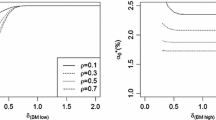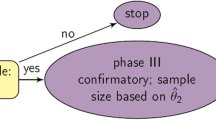Abstract
Background
The design and sample size of a phase III study for new medical technologies were historically determined within the framework of frequentist hypothesis testing. Recently, drug development using predictive biomarkers, which can predict efficacy based on the status of biomarkers, has attracted attention, and various study designs using predictive biomarkers have been suggested. Additionally, when choosing a study design, considering economic factors, such as the risk of development, expected revenue, and cost, is important.
Methods
Here, we propose a method to determine the optimal phase III design and sample size and judge whether the phase III study will be conducted using the expected net present value (eNPV). The eNPV is defined using the probability of success of the study calculated based on historical data, the revenue that will be obtained after the success of the phase III study, and the cost of the study. Decision procedures of the optimal phase III design and sample size considering historical data obtained up to the start of the phase III study were considered using numerical examples.
Results
Based on the numerical examples, the optimal study design and sample size depend on the mean treatment effect in the biomarker-positive and biomarker-negative populations obtained from historical data, the between-trial variance of response, the prevalence of the biomarker-positive population, and the threshold value of probability of success required to go to phase III study.
Conclusions
Thus, the design and sample size of a biomarker-driven phase III study can be appropriately determined based on the eNPV.





Similar content being viewed by others
Change history
14 April 2020
In the original article in the section “Application to the Motivating Example”, Greenberg’s trial data have been deleted from the historical data.
References
FDA. Critical Path Opportunities List. 2006. http://wayback.archive-it.org/7993/20180125035414/https:/www.fda.gov/ScienceResearch/SpecialTopics/CriticalPathInitiative/ucm076689.htm.
Sargent DJ, Conley BA, Allegra C, Collette L. Clinical trial designs for predictive marker validation in cancer treatment trials. J Clin Oncol. 2005;23:2020-2027.
FDA. Enrichment strategies for clinical trials to support determination of effectiveness of human drugs and biological products, 2019.
Patel NR, Ankolekar S. A Bayesian approach for incorporating economic factors in sample size design for clinical trials of individual drugs and portfolios of drugs. Stat Med. 2007;26:4976-4988.
Kirchner M, Kieser M, Götte H, Schüler A. Utility-based optimization of phase II/III programs. Stat Med. 2016;35:305-316.
Patel NR, Ankolekar S, Antonijevic Z, Rajicic N. A mathematical model for maximizing the value of phase 3 drug development portfolios incorporating budget constraints and risk. Stat Med. 2013;32:1763-1777.
Graf AC, Posch M, Koenig F. Adaptive designs for subpopulation analysis optimizing utility functions. Biom J. 2015;57:76-89.
Ondra T, Jobjörnsson S, Beckman RA, et al. Optimizing trial designs for targeted therapies. PLoS ONE. 2016;11:e0163726. https://doi.org/10.1371/journal.pone.0163726.
Kikuchi T, Pezeshk H, Gittins J. A Bayesian cost-benefit approach to the determination of sample size in clinical trials. Stat Med. 2008;27:68-82.
Tsai MS, Tangalos EG, Petersen RC, et al. Apolipoprotein E: risk factor for Alzheimer disease. Am J Hum Genet. 1994;54:643-649.
Risner ME, Saunders AM, Altman JFB, et al. Efficacy of rosiglitazone in a genetically defined population with mild-to-moderate Alzheimer’s disease. Pharmacogenomics J. 2006;6:246-254.
Poirier J, Delisle MC, Quirion R, et al. Apolipoprotein E4 allele as a predictor of cholinergic deficits and treatment outcome in Alzheimer disease. Proc Natl Acad Sci USA. 1995;92:12260-12264.
Greenberg SM, Tennis MK, Brown LB, et al. Donepezil therapy in clinical practice: A Randomized Crossover Study. Arch Neurol. 2000;57:94–9.
Winblad B, Engedal K, Soininen H, et al. A 1-year, randomized, placebo-controlled study of donepezil in patients with mild to moderate AD. Neurology. 2001;57:489-495.
Spiessens B, Debois M. Adjusted significance levels for subgroup analyses in clinical trials. Contemp Clin Trials. 2010;31:6470-656.
Millen BA, Dmtirienko A, Ruberg S, Shen L. A statistical framework for decision making in confirmatory multipopulation tailoring clinical trials. Drug Inf J. 2012;46:647-656.
Jenkins M, Stone A, Jennison C. An adaptive seamless phase II/III design for oncology trials with subpopulation selection using correlated survival endpoints. Pharm Stat. 2011;10:347-356.
Friede T, Parsons N. Stallard N. A conditional error function approach for subgroup selection in adaptive clinical trials. Stat Med. 2012;31:4309-4320.
Marchenko O, Miller J, Parke T, Perevozskaya I, Qian J, Wang Y. Improving oncology clinical programs by use of innovative designs and comparing them via simulations. Ther Innov Regul Sci. 2013;47:602-612.
Baras AI, Baras AS, Schulman KA. Drug development risk and the cost of capital. Nat Rev Drug Discov. 2012;11:347-348.
Chuang-Stein C. Sample size and the probability of a successful trial. Pharm Stat. 2006;5:305-309.
O’Hagan A, Stevens JW, Campbell MJ. Assurance in clinical trial design. Pharm Stat. 2005;4:187-201.
Neuenschwander B, Capkun-Niggli G, Branson M, Spigelhalter DJ. Summarizing historical information on controls in clinical trials. Clin Trials. 2010;7:5-18.
Ibrahim JG, Chen MH, Lakshminarayanan M, Liu GF Heyse JF. Bayesian probability of success for clinical trials using historical data. Stat Med. 2015;34:249-264.
Jawitz JW. Moments of truncated continuous univariate distributions. Adv Water Resour. 2004;27:269-281.
Buser SA. LaPlace transforms as present value rules: a note. J Finance. 1986;41:243-247.
Farrer LA, Cupples LA, Haines JL, et al. Effects of age, sex, and ethinicity on the association between apolipoprotein E genotype and Alzheimer disease. A meta-analysis. JAMA. 1997;278:1349–1356.
Kikuchi T, Gittins J. A behavioral Bayes method to determine the sample size of a clinical trial considering efficacy and safety. Stat Med. 2009;28:2293–2306.
Ranina P, Santaguida P, Ismaila A, et al. Effectiveness of cholinesterase inhibitors and memantine for treating dementia : evidence review for a clinical practice guideline. Ann Intern Med. 2008;148:379-397.
Funding
No funding source.
Author information
Authors and Affiliations
Corresponding author
Ethics declarations
Conflict of interest
No conflicts of interest.
Additional information
Publisher’s Note
Springer Nature remains neutral with regard to jurisdictional claims in published maps and institutional affiliations.
Electronic supplementary material
Below is the link to the electronic supplementary material.
Appendices
Appendix 1: Formulation of PoS
The PoS of the traditional and enriched designs is formulated as follows, using the predicted distribution of treatment effect in each population of equation (1).
The PoS of the stratified and adaptive enrichment designs is calculated by simulations. The PoS in these study designs is represented as follows based on the study success criteria in each design mentioned above.
Appendix 2: Expected discounted total revenue
In the case of success in enriched design, the expected value (\(E_{E} )\) and variance (\(V_{E} )\) of efficacy are calculated in the same manner as that in the traditional design. The expected discounted total revenue of enriched design (\(R_{{E_{n} }}\)) is given by:
The expected value of efficacy and its variance when the stratified and adaptive enrichment designs are successful are calculated by simulation. The expected discounted total revenue for sample size n in each arm of the stratified design (\(R_{{S_{n} }}\)) is given by
where \(E_{{S_{n} ,1}}\) and \(E_{{S_{n} ,2}}\) are the expected values of efficacy in the case of \(S_{S,1}\) and \(S_{S,2},\) respectively, and \(V_{{S_{n} ,1}}\) and \(V_{{S_{n} ,2}}\) are their variances. Additionally, the expected discounted total revenue for sample size n in each arm of the adaptive enrichment design (\(R_{{A_{n} }}\)) is given by
where \(E_{{A1_{n} ,1}} ,E_{{A2_{n} ,1}} ,E_{{A_{n} ,2}}\) and \(E_{{A_{n} ,3}}\) are the expected values of efficacy in the case of \(S_{{A1_{n} ,1}} ,S_{{A2_{n} ,1}} ,S_{{A_{n} ,2}}\) and \(S_{{A_{n} ,3}},\) respectively, and \(V_{{A1_{n} ,1}} ,V_{{A2_{n} ,1}} ,V_{{A_{n} ,2}}\) and \(V_{{A_{n} ,3}}\) are their variances.
Appendix 3: Expected phase III cost
The discounted phase III cost in the enriched and stratified designs is given below:
Additionally, let \(p_{k}\) ( \(k = 1, \ldots ,4\)) denote the probability of selecting case 1 to case 4 in Table 5 and \(C_{{A_{n} ,k}}\) denote the cost, excluding the interim analysis cost required in each case. The discounted phase III cost of conducting the adaptive enrichment design (\(C_{{A_{n} }}\)) is given by the following equation:
Note that
Appendix 4: The value of parameters used in the numerical example and the motivating example
Rights and permissions
About this article
Cite this article
Takazawa, A., Morita, S. Optimal Decision Criteria for the Study Design and Sample Size of a Biomarker-Driven Phase III Trial. Ther Innov Regul Sci 54, 1018–1034 (2020). https://doi.org/10.1007/s43441-020-00119-1
Received:
Accepted:
Published:
Issue Date:
DOI: https://doi.org/10.1007/s43441-020-00119-1




